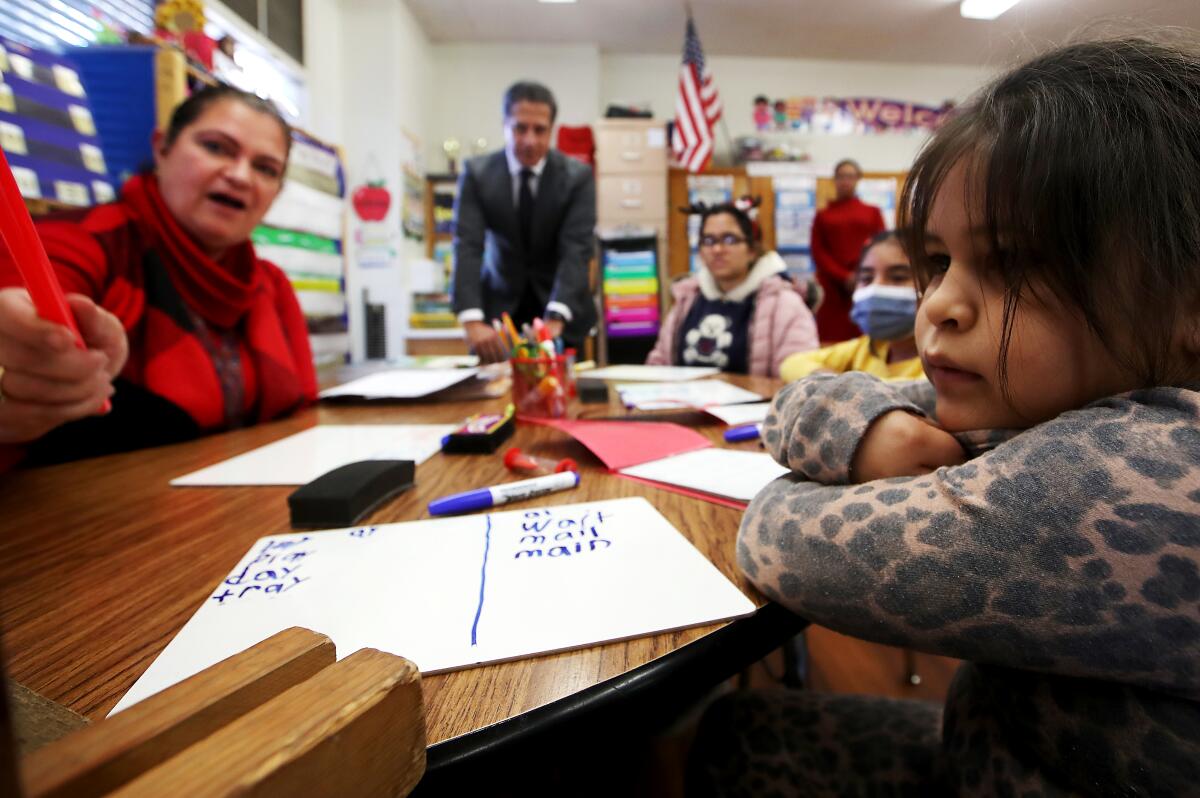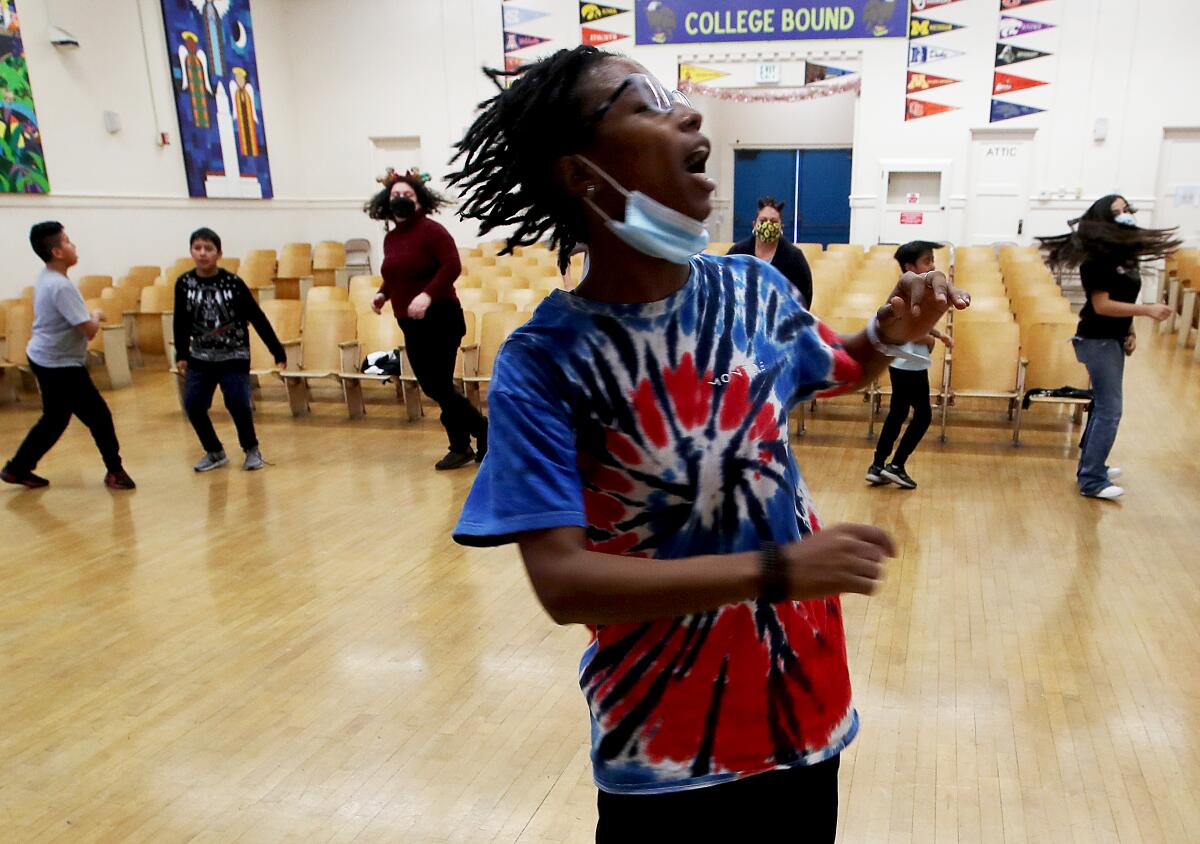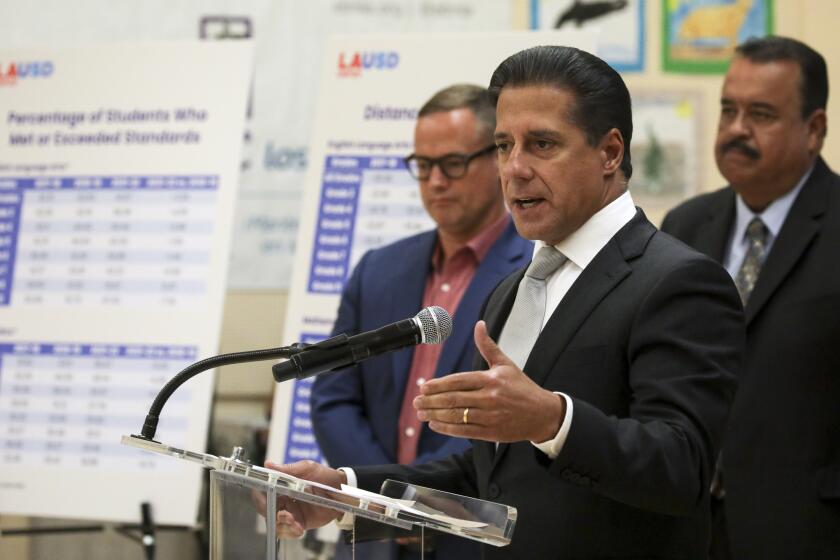At $611 a day per student, some question if L.A. schools’ extra learning days are worth it

The two second-graders in Susana Cabello’s class got a brief but exclusive education during the Los Angeles school district’s winter break. They had not only Cabello’s undivided attention all day, but that of a professional tutor as well.
This education booster shot came at considerable expense — about $611 per day per student for up to two added “acceleration days.” That same cost, multiplied over a 180-day school year, would total about $110,000 per student. By comparison, next year’s record state education funding will provide $23,723 per public school student.
The bonus schooling on Dec. 19 and 20 cost $36 million. After a heavy promotional push, about 17% of the district’s 422,276 students signed up; however, less than 9%, or 36,486 showed up, according to newly released data.
As the district evaluates the high cost and low attendance of the winter learning days — paid for with one-time state and federal COVID-19 funding — some officials, teachers and parents are questioning whether millions more should be spent on a similar effort during the first two days of spring break.
While Supt. Alberto Carvalho has repeatedly called the acceleration days a worthwhile investment — and offered Cabello’s class as one of many examples — others say another $30-some million could be better spent on different learning and enrichment needs.
“I still have a lot of questions,” said newly elected school board member Rocio Rivas, who represents a region that includes downtown and Boyle Heights. Rivas took office after the Board of Education approved the acceleration-day plan.
“These two first days of acceleration left a lot to be desired,” she said. “And yeah, parents were not sending their kids, so why are we going to spend another two days and we’re going to see the same results? It’s going to be a waste of money.”
In her view, the quality and organization of offerings varied substantially from campus to campus. She also would like to see a parent survey as part of any planning for the next days in April.
Rivas said academic field trips could be a better investment. Parents had wide-ranging suggestions, such as making campuses more secure or improving air filtration to cut down on the spread of flu, COVID-19 and respiratory syncytial virus, or RSV.
Leaders of the nation’s second-largest school system have pledged to prioritize learning recovery after test scores showed deep learning setbacks during the pandemic campus closures, followed by a year of skyrocketing absenteeism as COVID-19 surges continued. State test scores fell to their lowest levels in about five years, interrupting what had been steady, incremental progress. And even before the pandemic, most district students already were behind grade level in math.
The alarming dip in math proficiency and smaller declines in English in the last two pandemic-disrupted school years hit students who were already behind.
Carvalho sees value in the extra learning days, which are among his initiatives.
“What we keep hearing from the students ... is, if you had given us five days we would have come for five days,” Carvalho said after visiting Cabello’s classroom.
“Some people say: ‘Oh my God. That lady was only dealing with two students.’” Carvalho called this ratio “perfect.”
For the students who attended the extra days, “it makes a world of difference,” he said. “Do we have the capacity, the potential to actually do more? Of course.”
There were 10 students on the roster for Cabello and tutor Ananna Ahamed. Three showed the first day, and two the second.

Originally, the district’s plan had been to insert four acceleration days on Wednesdays at strategic points in the school year, which would have resulted in pushing back the last day of school by four days. Officials wanted to integrate these extra and optional days into a normal school week, making them seamless for schedules and harder to avoid.
The teachers union threatened a boycott and filed a legal challenge, saying the calendar change should have been brought to the bargaining table. The district backed down and negotiated what Carvalho called Plan B, which was expected to attract fewer students because the days fell on winter vacation.
Board member Scott Schmerelson said Tuesday that he was concerned that some employees might have discouraged families from participating, a reflection of political disputes rather than a focus on what’s best for students.
“One of the problems we had is that it wasn’t promoted enough by teachers in the school,” he said. “We should be constantly pushing the kids to be able to go to acceleration and not use it as a political football.”
Although there was no set attendance target by which to measure success or failure, Carvalho first announced figures that proved to be an overcount.
Near the end of the second acceleration day, Carvalho said attendance was 60,000 to 70,000 the first day and 50,000 to 60,000 the second day. A month later, at last week’s school-board meeting, officials cut those figures in about half. More specific numbers were provided Friday in response to a query from board member Nick Melvoin.
In all, 36,486 students attended one or both days. On the first day, 32,390 attended; on the second, 26,558 — 18% fewer. The total number of school days attended — 58,948 — works out to the $611 per school day per student.
Despite the cost, school board President Jackie Goldberg said she was cautiously encouraged because the vast majority of participating students were those identified as especially needing help.
“If that had not been true, if maybe, for example, parents took advantage of it for babysitting ... during the holiday, then I would say, ‘Oh my god!’ ” she said. “But when 83% of the kids who showed up were the kids that we wanted to show up, then that tells me that we may be on to something.”
She added that she saw good instruction taking place at the four campuses she visited.
Carvalho decided to open all 100 of the schools where students are struggling the most. This turned out to be key to attendance because relatively few families were willing to send students to an unfamiliar campus.
One choice that drove up costs also increased participation. The district opted to accept any students who showed up, even if they had not registered — and 5,699 students did so.
However, with attendance numbers so uncertain, the district was unable to predict staffing needs — and apparently accepted all teachers and staff who wanted to work, resulting in what teachers described as extensive and expensive over staffing. Administrators did not intend for class groups to be as small as they were.
Other problems emerged. Some teachers complained they were unable to plan effectively because they did not have advance access to rosters and student data. Under the plan, students were divided by groups into those who needed to catch up and those who would receive enrichment.
Andres Chait, chief of school operations, told board members that a high absentee rate was probably to be anticipated for this optional schooling. Thirty percent of those who registered for summer school — which, too, is optional — also didn’t show up, he noted. And nearly 1 in 5 students missed the last Friday before winter break, nearly double the normal absentee rate.
Many secondary students were using the extra days to raise a grade or pass a course — although students also could have turned in extra coursework completed at home. Several thousand students may have done that without attending the extra school days. The district extended the final grading window to Jan. 13, and officials said this week they are still compiling grade data.
Westside parent Basia Richard said she was frustrated that she found out at the last minute that the district decided to open her child’s campus.
But she found the extra school time positive.
“If I have a choice for her to stay home and do nothing and trying to entertain her, she might as well go to school,” Richard said. “She loves school. She learned a little. I didn’t see a reason why she wouldn’t go.”
More to Read
Sign up for Essential California
The most important California stories and recommendations in your inbox every morning.
You may occasionally receive promotional content from the Los Angeles Times.












